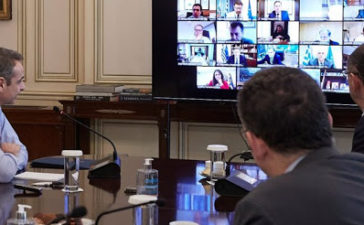Students studying abroad have difficulty getting home after countries close borders and restrict travel due to the coronavirus crisis. Some have gotten home, while others remain stuck in host countries.
When Will Rayner, a University of South Alabama student, traveled to Peru as part of a spring break study abroad program earlier this month, he never imagined he’d get stuck there or become one of thousands of Americans stranded overseas and having a terrible time trying to return to the United States.
But that’s exactly what happened after the Peruvian government, like governments of other countries responding to the deadly coronavirus pandemic, declared a state of emergency and suspended all international travel by land, air and sea. Rayner found himself separated from his group and unable to leave — and having to increase his credit card limits to book a stay in a Lima hotel — before he finally got home this past Saturday. His classmates remain stuck in Peru. (A South Alabama spokesman said the university is coordinating with other universities with students in the program, as well as government agencies, to arrange accommodations and flights back.)
“It’s one thing to be in a foreign country studying abroad — you know you’re coming home at some point,” Rayner said Friday from his Lima hotel before he left. “It’s just a completely different feeling when you realize you can’t get out of that country. You’re thousands of miles away from home, and there seems to be no hope for getting out anytime soon.”
As countries around the world have moved swiftly to close borders in efforts to contain the spread of COVID-19, students studying abroad have suffered the unintended consequences.
The Department of State told American citizens on March 19 to avoid all international travel. The State Department urged citizens already abroad in countries where commercial air travel was still available to arrange for flights home as soon as possible “unless they are prepared to remain abroad for an indefinite period.”
Many colleges and study abroad providers have recalled all their students worldwide. But for some students, the recalls — and the upgraded State Department warning — came too late. Students have been stranded in Ecuador, Morocco, Peru and other countries as nations have taken swift steps to close their borders and air corridors have narrowed.
It is unclear exactly how many study abroad students remain stuck overseas, but a State Department official said Monday more than 13,000 Americans have contacted the department for help getting home, according to USA Today. A senior State Department official said the department had already brought more than 5,000 Americans home from 17 countries and had scheduled flights over the next five days for 1,600 more.
“Special flights have been made available for U.S. citizens and U.S. lawful permanent residents to depart several locations where commercial flights are not available,” a State Department spokesperson told Inside Higher Ed. The State Department also has suspended all programs run through its Bureau of Educational and Cultural Affairs and is requiring the 1,500 program participants still in their host counties to return to the U.S.
“These are unprecedented circumstances,” the State Department spokesperson added. “We recognize the closing of borders and air space, lack of flights, and other local conditions make travel difficult and it may not be advisable to immediately repatriate all exchange participants. In these cases, ECA is working with U.S. embassies to adjust the timeline on which exchange program participants will be required to depart.”
Many stranded students have been able to return on U.S. government or privately charted flights, but not without difficulty.
The New York Times recently reported that Boston University spent $55,000 to charter a jet to evacuate students from Ecuador, where the government has prohibited the entry of all foreigners — leading to cancellations of commercial flights — and restricted movement within the country. Channing Stirrat, a junior at Oregon’s Lewis & Clark College who got on the Boston University-chartered flight out of Ecuador, told the Times she was disheartened by what she described as the U.S. Embassy and State Department’s inability to help stranded students. On its website, the U.S. Embassy in Quito said it “continues working hard 24/7 to arrange additional flights to help U.S. citizens return home.”
A group of physical therapy students from the University of North Carolina at Chapel Hill who traveled to Guatemala for a spring break service trip found themselves stranded after the Guatemalan government suspended all inbound and outbound commercial flights March 16. On Sunday the group reported on a blog about their experiences — they returned to the U.S. on a charter flight. A UNC spokesperson said the university worked with the U.S. Embassy on the students’ behalf.
The School for International Training, a Vermont-based study abroad provider that suspended all 56 of its spring semester programs worldwide last week, reported Monday that a total of 846 students — 92 percent of the students in SIT programs this spring — had returned home, including a group of students who had been stuck in Morocco. Another 2 percent — or 21 students, including all nine of its students who remained in Ecuador — were in the process of returning home.
Nineteen students on SIT’s program in Peru are sheltering in place in the country. Kate Casa, a spokeswoman for SIT, said the students in Peru are booked on a flight home on April 2 — after the state of emergency is scheduled to lift — but that the organization is “also working all channels to try to get them home earlier.” Another 15 students remained in Samoa, where there are complications with potential transit routes through third countries, though Casa said late Monday it appeared the students would be able to return to U.S. territory today or tomorrow on one of a limited number of flights between Samoa and American Samoa.
Numerous students were stuck last week in Morocco, where the U.S. government arranged charter flights to evacuate Americans after stranded citizens heavily criticized the State Department for what they characterized as its slow response. Robert Collar, an American student studying for a master’s in geology at McGill University, in Montreal, was part of a group of geology students in Morocco who got stuck after the Moroccan government announced closure of international travel on March 15. Collar and his McGill classmates caught a RyanAir flight out of Morocco to London arranged by the British Embassy.
“Unfortunately, both Canada and the U.S. were fairly late to the repatriation game, if you will,” Collar said. “There were a lot of other countries that started getting their citizens out before either Canada or the U.S.”
After landing in London, Collar was denied permission to board a plane to Montreal because of Canada’s ban on entry of foreign nationals. He is now back in California, where his family resides. (The Canadian government has since clarified that international students with valid or approved study permits will be permitted to re-enter Canada, but Collar said he was caught in the window before that policy was implemented.)
Ella Mascia, a junior at the College of the Holy Cross, in Massachusetts, who was studying environmental science in Peru this semester through the School for Field Studies, said she was able to return with two other students to the U.S. on a commercial flight before the Peruvian government’s restrictions on travel went into effect. But she said about 18 of her fellow students in the program remain in Cusco. She started a petition calling on the U.S. government to repatriate study abroad students who are stuck.
The president of the School for Field Studies, James A. Cramer, said that while students and staff are safe in Cusco, “We share parents’ and schools’ frustrations that students have not been able to return to their families.” He said the school has been working closely with U.S. and Peruvian government authorities and has also been working with their emergency evacuation insurance provider “to determine the feasibility of a chartered flight, both for our students and other programs with students stranded in Peru.”
On Monday, the U.S. Embassy in Peru said on Twitter, “All of our energy is focused on getting American citizens back safely to the U.S. So far today an additional 106 citizens departed, bringing the total to over 600.”
“I have a lot of friends back there still who are still waiting — they haven’t heard any concrete news yet,” Mascia said Monday. “Today has been a week since the three of us were able to leave, and it’s just been a lot of emails from the U.S. Embassy giving them updates saying charter flights are in the works, but every day nothing seems to happen; they haven’t been put on any manifests or anything. I think right now it’s a feeling of exhaustion of the cycle of getting hopes up and having those hopes crushed every time there’s some new news of getting flights out and other people getting out of Peru, and their time hasn’t come yet.”








